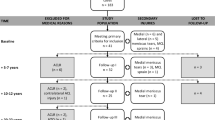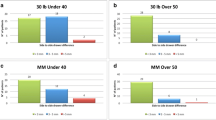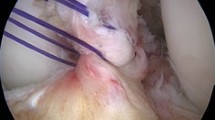Abstract
The aim of this study was to evaluate the effect of a standard postoperative rehabilitation knee brace on function, stability and postoperative complications at the 2-year follow-up after anterior cruciate ligament (ACL) reconstructive surgery. Seventy-eight consecutive patients with a unilateral chronic ACL rupture reconstructed by the same surgeon using the endoscopic “all-inside” technique, patellar tendon autograft and interference screw fixation were included in the study. The rehabilitation followed a standard protocol. Group A included 39 patients who were supplied postoperatively with a knee brace for 4 (range 3–6) weeks. Group B included 39 patients for whom a brace was not used. The median age was 27 (range 16–48) years in group A and 26 (range 14–51) years in group B. The median time period between the injury and the index operation was 24 (range 3–150) months in group A and 18 (range 3–360) months in group B. All 78 patients were re-examined by two independent observers after a median follow-up period of 25 (range 23–28) months in group A and 24 (range 22– 27) months in group B. The median KT-1000 total side-to-side difference between the reconstructed and the uninjured knees at 89 N was 3 (range –5.5–11) mm in group A and 3 (range –7–10) mm in group B (NS). When the anterior translation was tested separately at 89 N, the corresponding values were 3 (range –4–13) mm in group A and 3 (range –5–10) mm in group B (NS). The median one-leg hop quotient was 95% (range 50%–167%) of the uninjured leg in group A and 92% (range 64%–119%) in group B (NS). The median Lysholm score was 89 (range 39–100) points in group A and 85 (range 37–100) points in group B (NS). In group A, 27/39 (69%) patients and in group B 21/39 (54%) patients were classified as excellent or good (NS). The median Tegner activity level was 7 (range 3–9) in group A and 6 (range 3–9) in group B (NS). Using the IKDC scale, 27/39 (69%) in group A and 24/39 (62%) in group B were classified as normal or nearly normal (NS). The median sick leave in group A was 62 (range 0–357) days and 59 (range 0–243) days in group B (NS). No serious complications occurred during the first 6 postoperative weeks. Two serious complications were, however, registered after the 6th postoperative week. One patient in group A sustained a rupture of the reconstructed ACL 8 weeks postoperatively (3 weeks after removing the brace), and one patient in group B sustained an undislocated patellar fracture during the 7th postoperative week after a fall. This study indicates that the use of a postoperative rehabilitation brace after an arthroscopic ACL reconstruction did not appear to influence either objective stability or subjective function by the 2-year follow-up.
Similar content being viewed by others
Author information
Authors and Affiliations
Additional information
Received: 23 December 1996 Accepted: 15 April 1997
Rights and permissions
About this article
Cite this article
Kartus, J., Stener, S., Köhler, K. et al. Is bracing after anterior cruciate ligament reconstruction necessary? A 2-year follow-up of 78 consecutive patients rehabilitated with or without a brace. Knee Surgery 5, 157–161 (1997). https://doi.org/10.1007/s001670050044
Issue Date:
DOI: https://doi.org/10.1007/s001670050044




